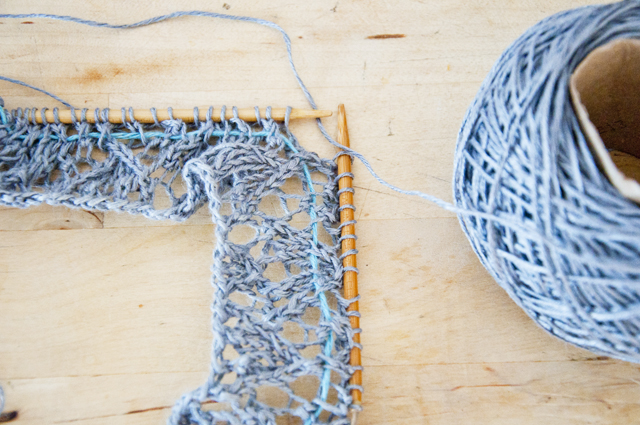Ripping back lace can be tricky. When stitches drop down, it can be difficult to see which go where and what row they belong to, so many knitters like to use lifelines if they’re not feeling confident about their lace. Lifelines are lengths of scrap yarn that are run through rows of your knitting and left until you feel confident that you won’t need to rip back to that point. If you do need to rip back, your stitches can’t drop down further than your lifeline, so you just need to follow the path of it to put them back on your needle. If you don’t need to rip back, you can simply pull out the scrap yarn with no harm done. This is just one of many methods to add lifelines, but it’s a good choice to pair with Zinone because it’s easy to work on plain rows.

To add a lifeline, you need your project on circular needles, a yarn needle, and a piece of slick, fine-weight scrap yarn that’s comfortably longer than your project’s width. Linen and cotton yarns are good choices for your scrap yarn because they won’t felt or stick, so I used leftovers from my first Zinone. You can add your lifeline on any row, but it will be easiest to insert just after you finish working a plain row, like the purled wrong-side rows on Zinone.

Slide your knitting back off of the shaft of your needle onto the cable so the stitches are slack.

Using the yarn needle, run the scrap yarn through the live stitches following the path of the circular needle’s cable. You want to go straight through all stitches, including slipped stitches, and YOs if there are any.

If you have any markers, be sure to go around the outside of them so the lifeline doesn’t go through them. You only want to capture stitches. If you go through the marker, it will get trapped, and you’ll have to cut it or the lifeline if it’s not a removable marker.

Once you’ve gone through all stitches, make sure you have a long enough tail on either end of your project that your lifeline won’t escape. You can just leave the ends dangling. Your length of scrap yarn should run parallel to your circular needle, from the beginning to the end of the live stitches of your project.

With your lifeline in, you can get back to knitting like normal. All you need to do is be careful not to disturb your lifeline. You don’t want to knit through it or involve it with the new row. Let it fall to the bottom of the stitches it’s inserted through and knit as usual. It might look funny when you work decreases, but as long as it’s staying in the row below, you’re fine.

Keep on knitting with your lifeline in place. It will be an easy point to rip back to if you need to because your stitches will stay exactly where they are on it, and you can easily remove it after you add another lifeline, get to the point where you feel more comfortable, or finish your project. If you’re not entirely confident about your lace, consider adding a few lifelines to your project so you can rip back without worry.
Leave a Reply